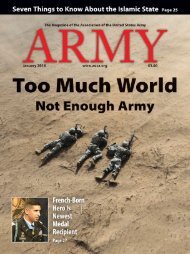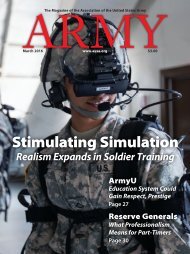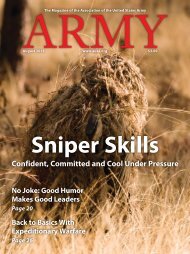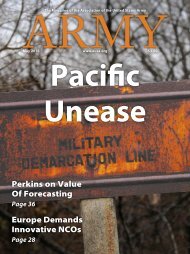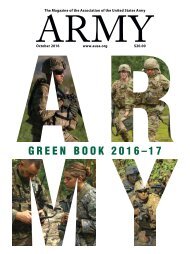Army - Kicking Tires On Jltv
You also want an ePaper? Increase the reach of your titles
YUMPU automatically turns print PDFs into web optimized ePapers that Google loves.
U.S. <strong>Army</strong>/Sgt. Alexandra Hulett<br />
U.S. <strong>Army</strong>/Pfc. Craig Philbrick<br />
Above: Soldiers from the 1st Armored Division<br />
and Spanish Legionnaires during African Readiness<br />
Training 15 in Spain; right: An 82nd Airborne<br />
Division soldier helps a Polish soldier during an<br />
exercise of NATO nations in Hohenfels, Germany.<br />
haps additional help for security cooperation,<br />
to the Department of State; and a<br />
new tool to keep American troops out of<br />
major foreign operations, to isolationists.<br />
These different interpretations point to a<br />
problem with the messaging associated<br />
with the concept of regionally aligned<br />
forces. This messaging problem leaves<br />
room for the criticism that the RAF concept<br />
is nothing substantially new but instead,<br />
a gimmick to defend force structure<br />
in a period of sequestration.<br />
Improve Concept<br />
The <strong>Army</strong> can, however, improve the<br />
RAF concept and its implementation and<br />
thus, reduce the risk of such an interpretation.<br />
Four concrete measures can help<br />
ensure that the RAF concept endures and provides better<br />
trained and available forces to the joint force while also contributing<br />
to the development of future leaders.<br />
First, the <strong>Army</strong>’s service component commands must search<br />
for opportunities for RAF units and soldiers to operate in<br />
their area of responsibility. The service component commands<br />
should work with partner nations to develop combined<br />
training activities, and also with the U.S. <strong>Army</strong> Forces<br />
Col. Allen J. Pepper is an infantry and Sub-Saharan Africa foreign<br />
area officer currently serving as the senior defense official/defense<br />
attache in Kinshasa, Democratic Republic of the Congo. He holds<br />
a bachelor’s degree from the U.S. Military Academy and a master’s<br />
degree from the University of Strasbourg, France.<br />
Command to provide the funding for RAF units to deploy<br />
and participate in this training. Section 1203 of the National<br />
Defense Authorization Act for 2014 authorizes expenditures<br />
for this kind of training, allowing the service component<br />
command to present attractive proposals to partner nations.<br />
In a time of reduced training money, the service component<br />
commands likely will face considerable resistance for such expenses.<br />
But the chief of staff’s prerogative for the <strong>Army</strong> to be<br />
the leader in the human domain makes such deployments important<br />
tools for <strong>Army</strong> readiness and relevance.<br />
In addition, the service component commands must work<br />
with geographic combatant commands to develop proposals<br />
for security assistance programs and cases, with the training<br />
aspects executed by RAF tactical units and soldiers from the<br />
34 ARMY ■ February 2016




